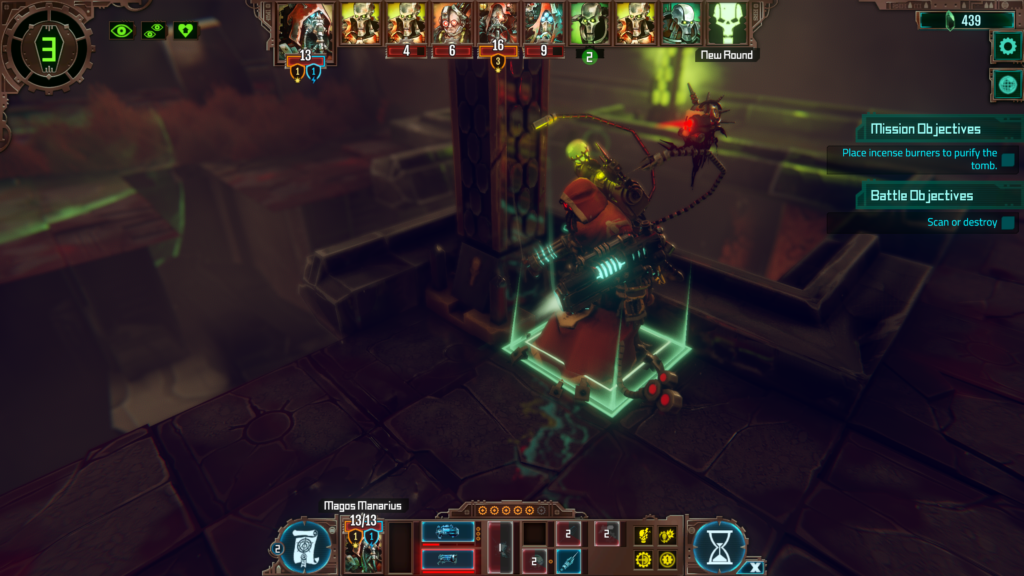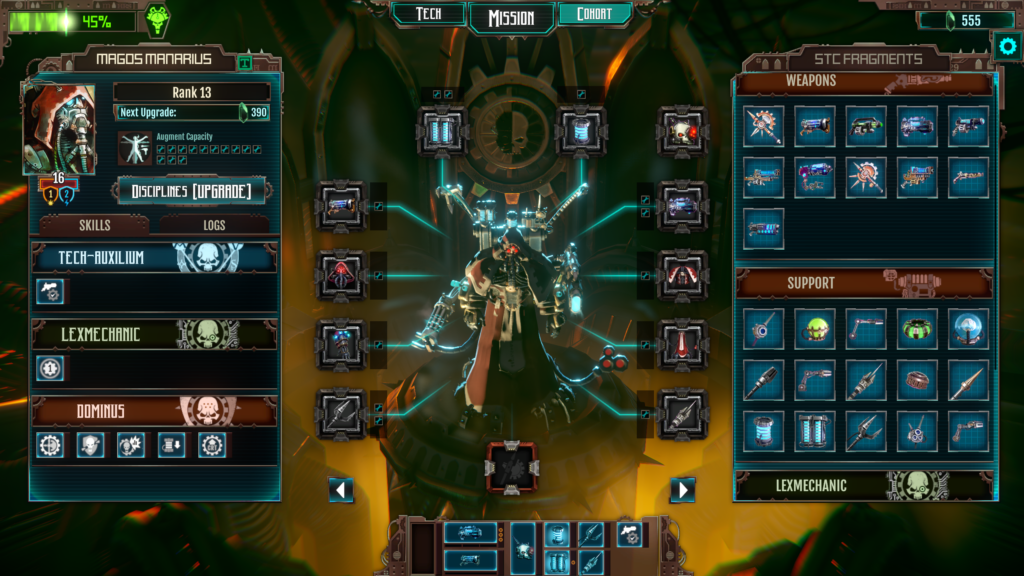
I have a soft spot for the Warhammer 40k turn-based games and this one even covers a more rarely seen faction: the Adeptus Mechanicus of the Imperium of Man. It seems obvious in retrospect how interesting it would be to pit them against the Necrons but it has never occurred to me either. What happens when the Mechanicus, who replace pieces of their flesh with cybernetics, encounters the Necrons who completed the same transition eons ago? This is a squad scale game so you actually are controlling individual Techpriests and their Skitarii soldiers as they explore a Necron tomb world. The upside is that it has enough customization options and novel mechanics to make it interesting. The downside is that it soon gets repetitive and is probably too easy.
Story-wise, the game involves a ship of the Adeptus Mechanicus arriving at the Necron planet of Silva Tenebris. As Magos Dominus Faustinius who commands the force you never personally head into battle but instead remotely oversee the squads deployed to explore the Tomb World from orbit. Naturally the Tomb World begins to wake up as a result of the activity. The game becomes a race against time as your cohort plumbs the tomb for its secrets and sabotages elements of the awakening Necron forces before the whole Tomb World fully activates. The resources and technological advances you obtain can be used to upgrade the capabilities of your cohort. Your different advisors and officers will give you options on missions to perform. Each of them have different priorities such as supporting the Skitarii troops, obtaining samples of Necron technology or sanctifying the Tomb. The ultimate aim is to locate the leaders of the Necrons and killing them.

I’ll skip over the parts where the turn-based combat is the same as other games and focus on what it does differently. First the entire squad, or cohort here, shares a Cognition resource. This is spent to activate many types of special abilities and even weapon attacks. At the beginning of the game you earn Cognition from sources on the map, either by standing near them or sending a Servo-skull there. Later you unlock more options to gain the resource through upgrades and equipment but managing it is always critical. Another key mechanic is that all units have separate defenses against physical and energy damage so you need to attack enemies with the correct type of weapon. That sounds normal enough except that you don’t get information about enemy stats for free. You actually need to use the Servo-skulls or some other ability to gather that information, including even the enemy’s hit points.
Combined with the extensive options to customize your Tech-Priests, that’s enough to give some richness to the tactical battles. At first you only get two of them so you need to fill out the rest of the Cohort with Skitarii troops that have fixed abilities. These troops cost Cognition to bring onto the field but their attacks and abilities don’t cost any resources to activate once fielded. As you complete missions, you can unlock more Tech-Priests and a larger Cohort as well as upgrade your Tech-Priests to specialize them into ranged, melee or support roles. The Tech-Priests have a lot of slots for equipment and augmentations on top of picking up skills from any tree. These can provide abilities to heal, to generate more Cognition, to erect shields or boost damage and so on. Finally if you need more help, there are also once-a-mission miracles called Canticles which can do anything from healing your troops to allowing your attacks to pass straight through the defenses of your enemies.

The game seems difficult at first, particularly as the first tutorial mission ends in a boss encounter that you are not meant to win. Some missions can be hairy as more Necron units appear turn after turn and you’re not sure what you need to do to stem the tide. Once you start building up your Tech-Priests however, the game becomes a cakewalk. You can reliably wipe out all Necrons in range every turn and between your shields and healing abilities, never need to sustain any damage. Even the bosses with their huge hit point pools aren’t much of a threat as you have plenty of tools by then to mitigate their damage and then it’s just a matter of burning their health down. Some of the tactical maps are laid out in a puzzle-like manner with moving platforms and barriers that turn on and off at regular intervals, necessitating some thought in how you move your units about. Still, it’s nothing very complicated and only makes a minor difference in difficulty.
The graphics here are adequate but nothing to shout about. The combat takes place entirely inside a Necron Tomb and so the place ends up looking very glowy and generic. More concerning is that there are display bugs in the information displays of in-game stats and some minor jankiness. I also found it frustrating how little detail is given about the scope and range of many abilities. The game simply tells you to learn as you go. In the end, it doesn’t really matter as you don’t need to optimize everything perfectly to do well but it feels grating. I do have kind words to say about the writing. It seems that they hired an established writer for the story and it shows. I love how your different advisers have disagreements about the best course of action and quote the Omnissiah or other authorities to buttress their respective arguments. Meanwhile the poor leader of the disposable Skitarii soldiers is left to mourn her soldiers herself.

On the whole the game is smaller in scope and easier than I’d expected. That’s good in that I have enough time to master the mechanics and it isn’t so long that it starts to drag. It’s a little disappointing in that I’d hoped for a more complex, more ambitious game.
One thought on “Warhammer 40,000: Mechanicus”